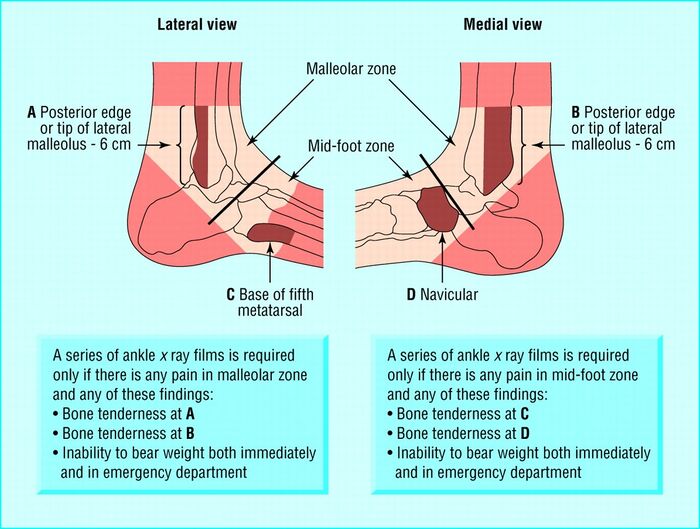◔
Ankle Sprain
From WikiMSK
This article is a stub.
Assessment
The Ottawa Ankle rule is an accurate instrument for excluding fractures of the ankle and mid-foot. Sensitivity is almost 100% and specificity is modest. It can be used to prevent unnecessary radiography in patients with suspected ankle sprains.[1]
A partial or complete lateral ankle ligament rupture is likely in the event of a haematoma accompanied by pain with palpation or a positive anterior drawer test or both. A delayed physical examination (4-5 days) is more accurate than 48 hours, with a sensitivity of 96% and specificity of 84% for detecting ligament rupture.[2]
Treatment
See Seah et al and Tiemstra et al for a review on management.[3][4]
- Mild to moderate ankle sprain: functional treatment options are better than immobilisation on multiple outcome measures. Functional treatment consists of elastic bandaging, soft casting, taping, or orthoses, with association coordination training
- Severe ankle sprain: This is controversial. It may be sensible to recommend 10 days of nonweightbearing and immobilisation in a cast or in a combination of a rigid splint and elastic bandage. Early functional rehabilitation can be initiated at the end of the period of immobilisation. A short period of immobilisation in a below-knee cast or pneumatic brace can result in a quicker recovery than tubular compression bandage alone.
- Supervised rehabilitation training in combination with conventional treatment for acute lateral ankle sprains can be beneficial, although some of the studies reviewed gave conflicting outcomes. Early mobilisation and focused range-of-motion exercises are preferred to prolonged rest.
- Cryotherapy can be used for the first 3-7 days to reduce pain and improve recovery time
- Lace-up supports are a more effective functional treatment than elastic bandaging and result in less persistent swelling in the short term compared to semi-rigid ankle supports, elastic bandaging, and tape.
- Semi-rigid orthoses and pneumatic braces provide beneficial ankle support and may prevent subsequent sprains during high-risk sporting activity.
- An air stirrup brace combined with an elastic compression wrap, or a lace-up support alone, reduces pain and recovery time after an ankle sprain and allows early mobilization.
- There is probably a role for surgical intervention in severe acute and chronic ankle injuries, but the evidence is limited.
Prevention
- Spraino is a novel low-friction patch that can be attached to the outside of sports shoes to minimise friction at the lateral edge and can reduce the risk of injury.[5]
- Patients at risk of reinjury should participate in a neuromuscular training program.
- Air stirrup braces, lace-up supports, and athletic taping can reduce the risk of ankle sprains during sports
References
- ↑ Bachmann, L. M., Kolb, E., Koller, M. T., Steurer, J., & ter Riet, G. (2003). Accuracy of Ottawa ankle rules to exclude fractures of the ankle and mid-foot: systematic review. BMJ : British Medical Journal, 326(7386), 417-417. retrieved from http://www.ncbi.nlm.nih.gov/pmc/articles/PMC149439/
- ↑ Kerkhoffs et al.. Diagnosis, treatment and prevention of ankle sprains: an evidence-based clinical guideline. British journal of sports medicine 2012. 46:854-60. PMID: 22522586. DOI.
- ↑ Seah, R. et al (2011). Managing ankle sprains in primary care: what is best practice? A systematic review of the last 10 years of evidence. Br Med Bull, 97, 105-135. doi:10.1093/bmb/ldq028
- ↑ Tiemstra, J. D. (2012). Update on acute ankle sprains. Am Fam Physician, 85(12),1170-1176.
- ↑ Lysdal FG, Bandholm T, Tolstrup JS, et alDoes the Spraino low-friction shoe patch prevent lateral ankle sprain injury in indoor sports? A pilot randomised controlled trial with 510 participants with previous ankle injuriesBritish Journal of Sports Medicine 2021;55:92-98.


